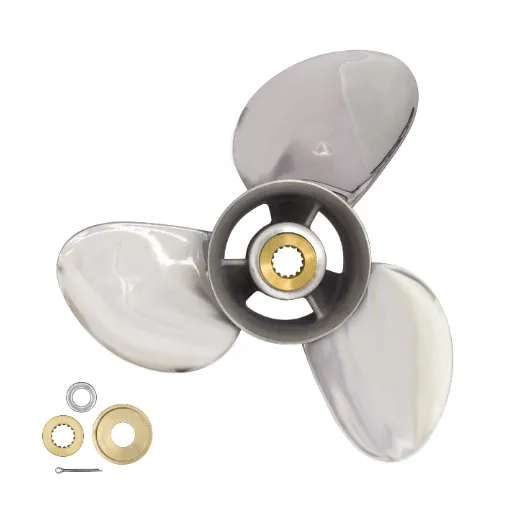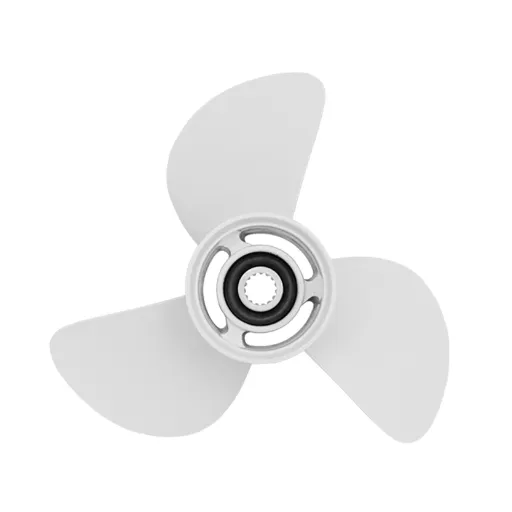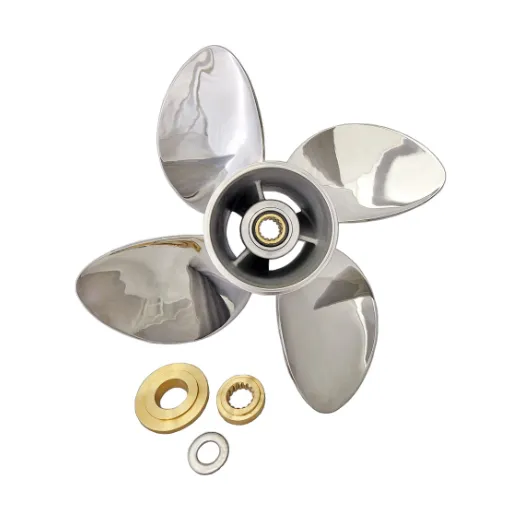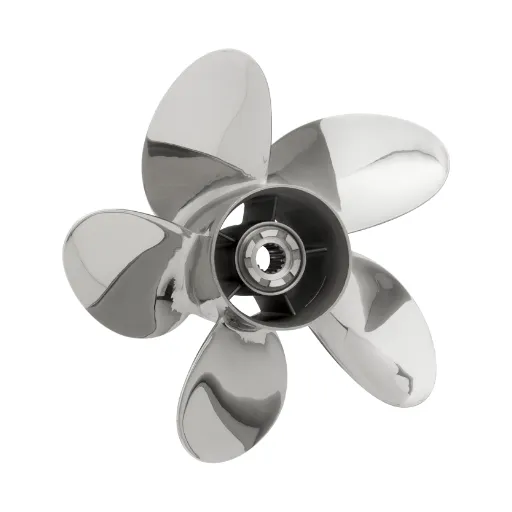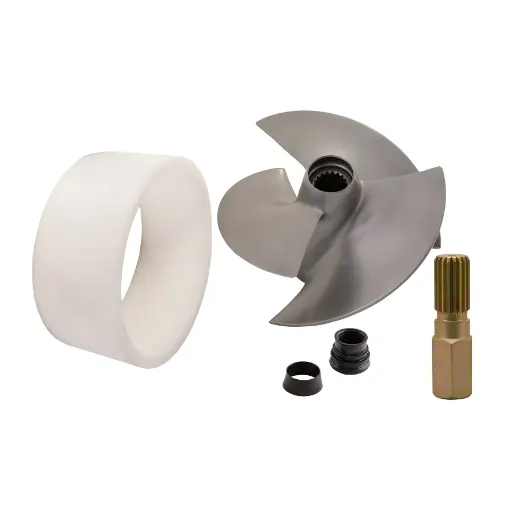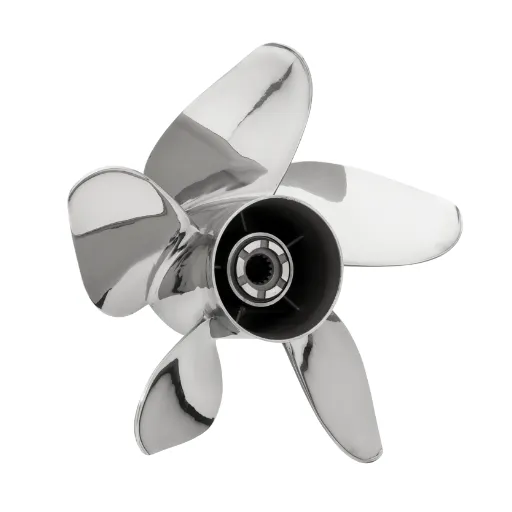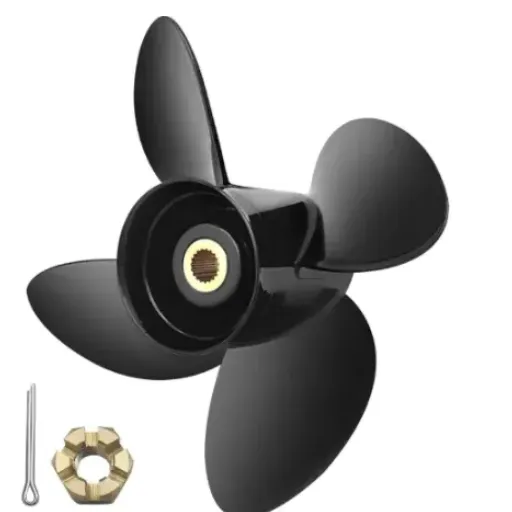The right propeller for your Yamaha 150 outboard is extremely vital to achieving top performance at optimum fuel efficiency and, on an overall note, having an excellent scuba diving and boating experience. Thus, it would be very challenging to make a rational decision with so much production available in the market. This article will bring to the attention of the reader some considerations of selection to weigh upon, hence, some factors that will determine your speed, handling, and engine efficiency. Do you want to maximize fuel economy or just want to enhance acceleration and control through different water conditions? Whatever it is, this guide is going to crumble the nuts for you in method selection for your Yamaha 150 outboard.
Understanding Yamaha Propellers
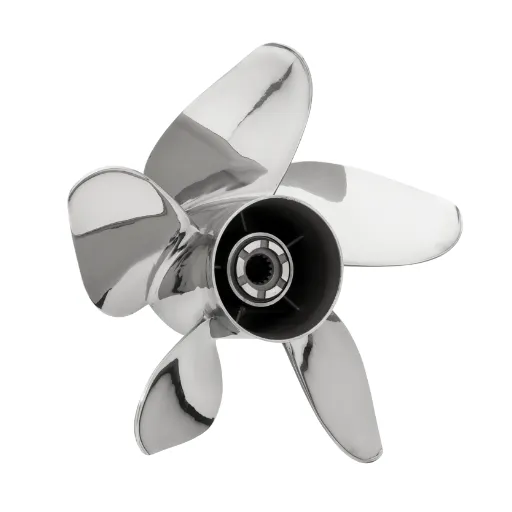
Types of Yamaha Props
Yamaha provides a vast array of propellers meant to fit different performance criteria and working conditions. Categorically, they can be divided into three major types depending on the material, design, and intent of application.
Aluminium Propellers
An aluminium propeller is lighter in weight, more economical, and suitable for typical day-to-day boating. The aluminum props are good for casual boaters or recreational purposes, and the performance-apt price mix appeals best. These props are good for operations where the propeller might be hit ever so often by debris underwater, since aluminum props are easier to repair and cheaper than higher-grade types.
Stainless Steel Propellers
An excellent reputation for reliability and high performance is what makes stainless steel propellers superior. They have further advantages over aluminum in that they do not corrode and provide better acceleration and top-end speed by virtue of being a stronger and thinner blade. Hence, such a type of propeller is suitable for high-performance boating operations, saltwater environments, or situations wherein long-term reliability is of utmost concern. That, however, places this propeller higher on the price scale and is thereby suited for high-end boating or specific performance requirements.
Specialty and High-Performance Propellers
Specialty propellers, such as Yamaha’s Saltwater Series II or V MAX SHO series, are meant for special uses such as offshore fishing, racing, or watersports. These props, with their sophisticated designs, are meant to improve thrust, handling, or working conditions. For example, the Saltwater Series II is designed for larger boats with massive horsepower, while V MAX SHO props give the best acceleration in bass or speed-tailored applications.
Important Note: As mentioned earlier, propeller considerations are based on your boat’s size, engine horsepower, and intended application. Selecting an appropriate type of propeller for your vessel will boost your performance while conversely saving you precious fuel and easing your handling on varying water conditions.
Key Features of Yamaha Propellers
- Precision Engineered Design: Yamaha propellers are designed by engineers aiming at performance and durability. They use precision casting methods that minimize vibrations and allow smooth functioning, thus augmenting the absolute boating experience.
- Corrosion Resistance: The Yamaha propellers are made from high-grade materials such as stainless steel and aluminum, with coating technologies that resist corrosion. This makes them ideal in environments such as saltwater and other corrosive marine environments.
- Wide Variety for Specified Applications: Yamaha also carries a wide array of propellers, each designed for a specified type of boat or engine. Whatever the need– high speed for bass boats or torque for bigger vessels– Yamaha has a propeller for it.
- Efficiency in Operation and Fuel Economy: Improving fuel economy and watercraft operations through the best blade geometry and slip characteristics are the qualities of Yamaha propellers. Their precise tuning allows good handling, acceleration, and top speed with the least energy consumption.
- Customization Option: To suit various boating needs, Yamaha offers a wide range of pitches, diameters, and blade designs to ensure that a propeller fits an engine horsepower and the boat’s intended application, whether fishing, cruising, or competition.
Summary: Such traits make Yamaha propellers a prominent choice among boating enthusiasts on the lookout for reliable equipment that guarantees high performance in all water conditions and operating styles.
Importance of Spline Count
Having a certain spline count on the propeller shaft will allow proper interface of the propeller with a particular engine type. The term spline describes grooves machined onto the propeller shaft-chairing with the grooves in the prop hub-that will allow a secure fit without slipping and the full transfer of torque from the engine to the propeller. Efficiency and serviceability require that the spline count in the propeller correspond to the spline count required by the shaft of the engine.
Warning: If the spline count does not match, numerous operational troubles can arise, varying from inability to destruction of the propeller. Improper spline count will cause the propeller to loosen, vibrate, and damage the shafts, or even the loss of the propeller in operation. The manufacturers specify the proper spline counts for the particular engine models to avoid such situations and along with orientation for correct operations.
Again, spline count is related to power distribution. For shafts that manufacturers intend for engines of higher horsepower, more splines exist on them to face and deal with better torque and other demanding situations. With the most appropriate spline count, a boater maximizes the performance of the entire propulsion system while minimizing the wear and tear on the components.
Choosing the Right Propeller for Your Needs
Factors to Consider When Selecting a Prop
Certain considerations must enter into the trade-off for an optimal propeller concerning compatibility and efficiency. First among these are the diameter and pitch of the propeller, because they determine how engine load is translated to thrust and acceleration of the vessel. Generally, propellers of larger diameters are best suited to slow vessels that will need thrust, while higher pitch serves the faster boats that sail across the water at higher speeds.
Material selection is, therefore, an important aspect: aluminum propellers are light, inexpensive, and suitable for recreational use; however, stainless-steel propellers are more suitable in harder conditions that require good durability and performance, such as high-speed boating or heavy loads.
Hence, blade count has an important effect on the performance characteristics as well: three-blade propellers reach higher top speed and are generally used for general-purpose applications, whereas the four-blade types are used for better acceleration, smoother ride, and extra handling in adverse conditions.
Finally, one has also to consider any special device compatibility, such as engine RPM range, propeller hub design, and spline count, to ensure maximum performance with minimum mechanical stress. If measurements respect precision, and a perfect knowledge of the surrounding or operational conditions is attained, the chosen propellers will definitely enhance propulsion efficiency while supporting steady engine function.
Matching Propeller Pitch with Engine HP
Matching the propeller pitch with engine horsepower (HP) is essential to having the best performance, fuel efficiency, and minimizing wear on the engine itself. The propeller pitch, theoretically defined as how far a propeller would move through water during one revolution, should fit into the power rating of the engine and its RPM range. More pitch tends to be needed for high-horsepower engines because the engine will not run over its maximum permissible RPM when properly used; on the contrary, lower horsepower engines are best with lower pitch propellers since it enables the engine to reach speeds in the recommended RPM range without exceeding the engine.
Technical Note: Data indicated that if an engine is allowed to operate either above or below its optimum RPM, which is generally stated in the manufacturer’s guidelines, it may face increased mechanical stress and shortened operational life. For example, 4,500–5,500 RPM-rated engines must be coupled with a properly pitched propeller that would allow the engine to operate within this range under standard load conditions. Weight distribution, boat size, and water conditions must be considered in this process, too, as all of these factors can influence the engine’s ability to hit and hold onto its optimum RPM.
Through the use of computational tools complemented by performance-based testing, propeller pitch selection has gained increased accuracy. Engine performance curves, when combined with hydrodynamic testing, can now be used to determine and calculate the best propeller for specific engine and vessel combinations. This technical alignment ensures that thrust, speed, and fuel consumption are balanced, a prerequisite to high operational efficiency.
Evaluating Blade Count: 3 vs 4 Blades
| Blade Configuration | Advantages | Best For |
|---|---|---|
| 3-Blade Propellers | Maximizes top-end speed, minimizes drag, better fuel economy, and reduces component wear | Lighter craft, high velocity applications, moderate load demands |
| 4-Blade Propellers | Better thrust, smooth operation, improved maneuverability, reduced vibrations | Larger vessels, turbulent water, heavily loaded conditions, comfort priority |
The selection of a 3-blade or 4-blade propeller directly affects the vessel’s character, style, and manner of operation. A 3-blade setup maximizes top-end speed and minimizes drag by having less surface area. It does well with lighter craft or in cases that may require high velocity with moderate load demands. Fuel economy is obtained when an engine is kept near its own peak power output. Consequently, the economy increases, and component wear is limited.
When thrust is demanded, and smooth operation is desired at lower speeds or in situations of higher hydrodynamic resistance, 4-blade designs perform better. The extra blade increases propeller hold in the water, raising levels of maneuverability and lowering vibrations. The 4-blade configuration, therefore, is preferred for larger vessels where comfort and steady performance are key considerations. It performs exceptionally well in turbulent water and under heavily loaded conditions by providing steady thrust and limiting cavitation.
Research Conclusion: According to statistical analyses and experimental results, 3-blade propellers generally deliver more performance with light vessels or where top speed is the paramount objective, in accordance with the theory of reduced drag and more straightforward propulsion. On the flip side, 4-blade propellers shine wherever torque, stability, or fine control is required. Hence, their choice depends on requirements arising from actual operations, vessel configuration, and governing engine output for the best compromise between performance and efficiency.
Performance Benefits of Optimal Propeller Selection
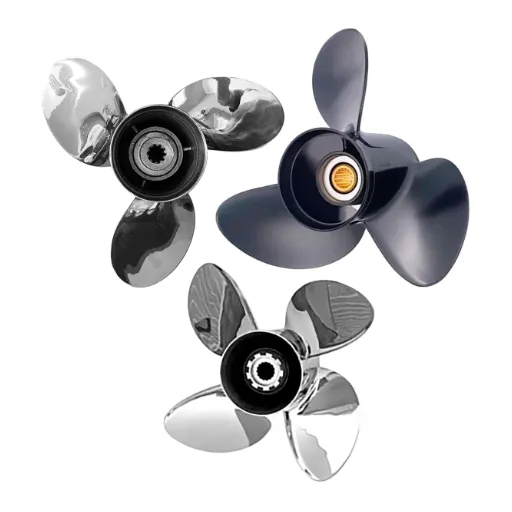
How Propeller Design Impacts Fuel Efficiency
Propeller design greatly impacts fuel efficiency, depending on how a vessel translates engine output into forward thrust. A fine propeller minimizes hydrodynamic resistance and thus energy wastage and fuel consumption. Significant factors affecting this relationship are pitch, diameter, and surface area of the blades, as these influence the displacement and resistance offered by water.
At some extremes, lighter-pitched propellers might be the best fit for vessels working under lower speeds, whereas coarser pitch finds its place under environments requiring higher speeds and thrust. On the other hand, appropriately sized blade diameters transfer energy directly, while oversize and undersize cases place excessive load on the engines, thereby consuming more fuel. Then again, the shape and the number of the blades come into play: fewer blades tend to be more efficient, minimizing drag but compromising on stability; more blades could counteract this by offering more thrust with slight resistance. Then, there is the matter of advanced materials or coatings, let alone low-friction composites or anti-fouling coatings, which would curb drag and enhance fuel economy by minimizing frictional losses.
Therefore, it comes down to the exact design of the propeller, matching the operational profile of the vessel pertinent to period, speed, load, and water conditions, which will lead to fuel efficiency. Further optimization with CFD modeling and real-performance testing is becoming the new standard in propeller design, giving quantifiable data that provides alternatives for improving performance while reducing environmental impact.
Understanding RPM and Speed Correlation
Inherently, the relationship between revolutions per minute (RPM) and speed through the water is governed by factors such as propeller type, hull form, and hydrodynamic resistance. RPM is the number of revolutions made by the propeller in one minute; these revolutions produce thrust, thus affecting the speed of the vessel. This relationship between RPM and speed, however, is not linear due to such factors as cavitation, slip, and variations in hydrodynamic efficiency as related to different speeds.
As an example, at low speeds, little hydrodynamic resistance exists, and rises in RPM normally correspond to linear increases in speed. But as the speed of a vessel grows, so does the hydrodynamic drag, requiring disproportionately higher increments of RPM to gain further increments of speed. The ship’s hydrodynamics terms this effect as the speed-resistance quadratic relationship. Another factor complicating the relationship is the propeller slip, which essentially constitutes the difference between the theoretical advance of the propeller through water at a given RPM and the actual vessel movement.
Modern Technology: To quantify the relationship and, hence, optimize the performance of a vessel, sophisticated measurement devices such as torque meters and speed loggers integrated with GPS are employed to monitor precisely the RPM, the speed, and the fuel consumption. The simultaneous consideration of these real-time data, joined with computational fluid dynamics (CFD) modeling, allows operators to determine the optimum RPM range that consumes the minimum amount of fuel without subjecting the vessel to mechanical limits beyond safety. Such data acquisition and application must be fully understood by ship operators aiming to maintain the delicate balance between economy and environmental safety.
Optimizing Performance for Different Boating Conditions
A vessel’s performance can be optimized by considering the pertinent operational factors-operational weather conditions, wave characteristics, and load distribution. Operators could sustain high cruising speeds with moderate fuel efficiency in calm waters with low wave heights. Conversely, lower speeds and more conservative power settings under high wave activities become essential to lessen structural stress and gain overall stability for the vessel.
These conditions can be assessed with great precision, in real time, by employing advanced systems using modern technology, such as real-time GPS tracking, sensor arrays, and software route optimization tools. For instance, operators use dynamic trim monitors to detect any deviations from an intended vessel balance and adjust the ballast to achieve the best hydrodynamic efficiency under different load levels. Likewise, weather routing algorithms combined with marine propulsion systems can predict the wind and current systems so that the operator can take the most optimal route concerning adverse conditions.
By looking at these variables through data-centered lenses, vessel operators enhance performance while lowering operating expenses and environmental damage. The integration of such technology-founded methodologies is increasingly seen as an inherent part of modern maritime conduct, assuring safety, sustainability, and increased profit in all types of boating conditions.
Maintenance Tips for Yamaha Propellers
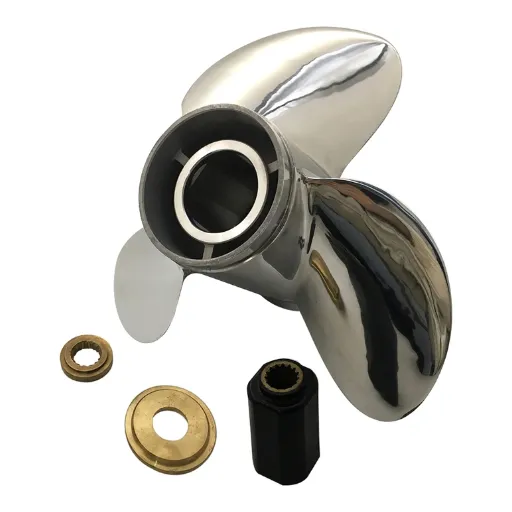
Routine Inspection and Care
Maintenance of Yamaha propellers is very important for their proper working and life. Normally, inspection begins with a close examination of the blades for damage, such as chips, cracks, and bent edges. Even minor imperfections can cause great inefficiency in propelling and excessive fuel consumption. Corrosion must be checked for, especially in a saltwater atmosphere, where, due to the presence of electrolytes, the process of corrosion takes place at an accelerated rate.
- Step 1: Remove the propeller from time to time and check for wear or debris on the shaft and spline, as such matter prevents proper seating and thus causes vibration.
- Step 2: Use marine-grade grease when refitting to prevent friction and rust build-up on the propeller.
- Step 3: Correct torque on the prop nut must also be checked and maintained to prevent loosening during operation.
Cavitation Warning: If not attended to at the outset, it forms one of the toolbox problems faced almost daily among those dealing in propeller maintenance-Cavitation damage is one of the problems to watch. Cavitation generally displays itself as pitting or rough surfaces on the blades and can reduce thrust efficiency. Avoiding engine thrust misalignment and improper pitch can help to keep cavitation at bay.
Following the inspection and maintenance procedures given above will permit Yamaha propellers to operate at their pinnacle performance level and help save unnecessary repairs and downtimes.
Extending Propeller Life: Best Practices
The operational life of a propeller is increased through a comprehensive program of inspections, correct usage, and preventive maintenance. Regular inspection of the propeller for signs of wear, bends, cracks, or corrosion can prevent small problems from escalating into severe mechanical failures. Further, carrying out the installation with proper torque settings will result in less stress on the hub and blades, which otherwise would grow into fatigue, damaging the properties over time.
Operating Conditions
Operating conditions with set also enable the best durability conditions. The operators should thus avoid overloading engines, thereby maintaining certain RPM levels, as they exert unnecessary stress on the propeller.
Material Selection
Another important factor affecting long-term reliability is the proper selection of the propeller material for the application: aluminum alloys are generally used for recreational boating, while stainless steel is favored for performance and durability.
Protection
For marine vessels operating in a harsh environment, applying protective coating serves as protection against corrosion resulting from saltwater and marine growth.
Storage
During the off-season, propellers should be adequately stored in a well-controlled environment, free from moisture and temperature fluctuations, so as to avoid any form of structural degradation.
Long-term Benefits: Such a wide range of best practices will ensure that replacement is less frequent, thereby lessening lifecycle costs attached to Yamaha propeller systems, besides guaranteeing optimal performance.
Analyzing Propeller Specifications
The Role of Diameter in Performance
A propeller diameter is critical for determining a given propeller’s overall performance and applicability to different marine purposes. The diameter is the distance across the circle made by the rotating blades and has a direct effect on the thrusting power, speed, and fuel efficiency of a vessel. An increase or decrease in diameter affects many performance criteria, so it is important to understand these for better propeller selection. The following are the five points on the diameter that shed light on its importance with respect to propeller performance:
- Thrusting Power: A Larger diameter moving one sort of water per revolution will give more thrust. This is useful for vessels requiring more pulling power, such as tugboats and trawlers operating in heavy load conditions.
- Engine Loading: The diameter sets the load on an engine. An increase in diameter may increase engine load if not supplemented by higher horsepower, which causes overheating or damage in the long run.
- Speed Optimization: For speeds, smaller diameters are more appropriate since they cause drag and prevent very fast rotations. It also makes them good for speedboats or recreational craft on the agility side.
- Cavitation: On the other hand, too small a diameter causes cavitation, where low pressure around the blades causes the formation of water vapor bubbles, which damage the blades with time.
- Fuel Ability: The right diameters will let you have good fuel consumption by maintaining a fine balance between engine power output and water displacement. Over and undersized propeller diameters will make fuel consumption above average since the conversion from energy to propulsive effort is not very efficient.
Key Takeaway: By carefully analyzing the diameter with respect to the operation of a vessel, operators can maximize performance and help extend the functionality of the propeller and the engine system.
Impact of Pitch on Thrust and Speed
The thrust created by a propeller and the speed imparted to the vessel depend strongly on the pitch of the propeller, which is defined as the advance per full revolution theoretically accomplished by the propeller. An accurately determined pitch will ensure maximum efficiency. The following are the five detailed effects of pitch on thrust and speed:
- Thrust Efficiency: As pitch increases, due to more water being moved by the propeller in each rotation, thrust efficiency becomes higher at high speeds. Yet, an excessive pitch can result in cavitation, leading to a drop in overall efficiency and possible structural damage to the propeller.
- Engine Load: The pitch offers resistance to the engine. A large pitch could overload the engine, damaging the price of its longevity, adversely affecting fuel efficiency. Too low a pitch deals less resistance to the engine, and it runs almost free, thus decreasing the efficiency of propulsion.
- Fuel Consumption: Correct pitch causes the engine to operate at the best RPM and balanced fuel consumption, while wrong pitch causes more energy conversions, thereby increasing operating costs.
- Potential Vessel Speed: Maximizing the designed speeds of the vessel is realized when the pitch is balanced properly. An excessive pitch will cause desired speeds not to be attained owing to engine strain.
- Acceleration and Maneuverability: Low pitch gives better acceleration and good low-speed maneuverability, which are useful for vessels with a lot of stopping and turning, such as fishing boats and harbor tugs.
Optimization Note: By adjusting pitch for the needs of the vessel, operators can fine-tune performance, while also providing increased engine life and improved operational economy.
Choosing Between Standard and Performance Props
| Propeller Type | Characteristics | Ideal Applications |
|---|---|---|
| Standard Propellers | Cheap, reliable, moderate performance, durable, easy to service | Recreational boating, general-purpose applications, and cost-sensitive operations |
| Performance Props | Better speed, accuracy, thrust, custom materials, special blade designs | Racing, water sports, heavy applications, demanding conditions |
As a proponent of decision-making in any matter concerning standard or performance prop, I first consider the main design of the vessel and its operational purpose. Standard propellers present an attractive case since they are cheap and reliable and should be best suited for any vessel that only insists upon a moderate level of performance regularly. Such propellers tend to attract the recreational boaters or the vast majority of people who set a yardstick in durability and ease of service without paying for previously advertised extra characteristics.
Conversely, performance props tend to offer better speed, accuracy, and thrust, therefore being the one to be chosen when the utmost performance is requested. For example, the benefits of performance props with better manufacturing can be truly felt by boats used in racing, water sports, or heavy applications. They can be custom-made from special materials employing special blade designs to generate thrust as efficiently as possible while running under harsh and demanding conditions.
Decision Framework: Ultimately, weigh the cost of durability versus performance needs. Upon consideration of the vessel’s main purpose, engine horsepower, and the speed-to-efficiency ratio it should try to favor, I can satisfactorily determine the instrument that would better do. By following this simple procedure, the propeller not only fits into the present demands of the vessel but also perfectly connotes further successful performance and stay.
References
-
Wesleyan University Digital Collections: Discusses Yamaha’s corporate and motor divisions, providing in-depth insights into their operations and innovations.
-
Academia.edu: Covers technical details about outboard engines, including Yamaha models, with a focus on propeller specifications and performance.
-
ERIC (Education Resources Information Center): Offers a training manual on marine fisheries, including information on outboard engines and their applications in small-scale marine operations.
Frequently Asked Questions (FAQ)
Ready to Optimize Your Yamaha 150 Outboard?
Choose the right propeller today and experience the difference in performance, efficiency, and reliability that comes with proper selection and maintenance.




